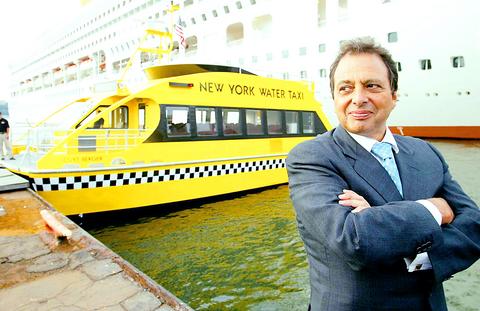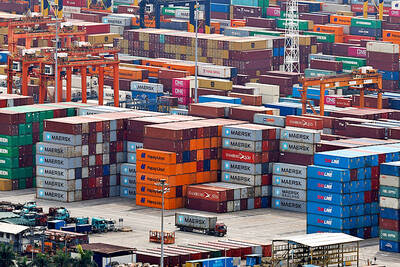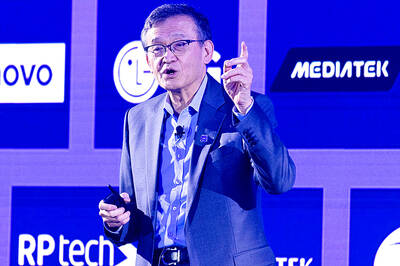A small yellow catamaran skimmed down the Hudson the other day, looking nothing like the lordly ferries that dominated the river back in the days of Commodore Cornelius Vanderbilt.
Atop the catamaran stood a man, looking nothing at all like Vanderbilt.
In fact, when someone asked if he considered himself a budding commodore, he just smiled uncomfortably. "I haven't thought about that," he said into the wind. But the comparison is not so outlandish: The man was the developer Douglas Durst, the head of one of the most successful real estate dynasties in New York, with 2.286m2 of Manhattan office space and a fortune estimated at more than US$2 billion.

PHOTO: NY TIMES
The railroad tycoon Vanderbilt began building his fortune with waterborne mass transit, and his family later amassed huge real estate holdings. Durst may have the same aspirations, but is going about it in reverse. His family has the real estate. And now, in his first foray into transportation, Durst has dipped a toe -- or a whole foot -- into New York Harbor, where private ferries have begun to re-emerge as much more than just a nostalgic way for commuters and tourists to get around.
Durst's decision is significant not only because of the US$4.5 million he has quickly spent to revive a fledgling ferry company called New York Water Taxi, whose catamarans began plying passenger routes around Manhattan and Brooklyn again this week. For the first time since 1986, when the trucking and real estate magnate Arthur Imperatore had the romantically ambitious idea of ushering in a new age of the ferry and founded New York Waterway to do that, an investor with even deeper pockets and an equal reputation for tenacity has come along to challenge the harbor's reigning king.
Both Durst and New York Waterway, whose president is now Arthur E. Imperatore Jr., try to play down any notion of a riverine clash of titans. "I frankly welcome their entry into the market," Imperatore said recently. "The waterfront community is a very small community, and we need to cooperate as much as possible to make it work."
New York Water Taxi's founder, a longtime harbor activist named Tom Fox, said that what he and Durst plan is relatively humble, what his company failed to do in 1997. That is to provide frequent, multistop intra-city ferry service, using the waters around Manhattan much as cabs use its streets (except you can't hail one at the dock). A rush-hour fare is US$3.
By contrast, the Imperatores have built their considerable empire -- it is now the nation's largest private ferry company, carrying 65,000 passengers a day -- largely on bringing people into the city from New Jersey. The fares vary by destination from US$80 to US$200 a month.
While both sides try to put on congenial faces, emphasizing that their businesses will complement each other more than compete, there is already a steady undercurrent of competitive ill will. Durst signaled this clearly one windy afternoon on the viewing deck of one of his new 16m boats, when asked whether he had consulted Imperatore.
They met, he said, and Imperatore warned that there was probably not enough business to sustain a new ferry service. Durst smiled tersely later as he rendered his interpretation of that advice: "Basically, that the waterfront is not big enough for the both of us."
Imperatore remembers it differently, saying he had warned only that "it may be an idea that's slightly ahead of its time."
For fans of the return of ferry service to New York Harbor, this kind of rivalry, far from discouraging, is actually a healthy sign -- that business is now vigorous enough to allow for good old-fashioned New York infighting.
Durst complains that the inequities between the two companies run much deeper than the size of boats or fleets. He said that he had been frustrated by what he saw as an official bias toward the Imperatores, longtime contributors to Governor George E. Pataki. For instance, New York Waterway receives US$2.5 million a month in federal subsidies, administered by the city and state, to run increased service between Hoboken and Lower Manhattan.
The younger Imperatore stresses that his company was asked by city and state officials to provide that service.
Water Taxi has also received about US$1 million to build ferry slips, but Durst said the money was long in coming. "When we started we found not just the absence of a level playing field, but that the gate to the game was barred," he said. "Without Tom's tenacity and my persistence and the reputation and assets of the Durst Organization, any other startup would still be on the outside looking in."
He added: "We've gotten absolutely nothing besides verbal encouragement, which is nice, but when you read about the millions and millions that are flowing to others, you have to wonder what's going on here."

The Eurovision Song Contest has seen a surge in punter interest at the bookmakers, becoming a major betting event, experts said ahead of last night’s giant glamfest in Basel. “Eurovision has quietly become one of the biggest betting events of the year,” said Tomi Huttunen, senior manager of the Online Computer Finland (OCS) betting and casino platform. Betting sites have long been used to gauge which way voters might be leaning ahead of the world’s biggest televised live music event. However, bookmakers highlight a huge increase in engagement in recent years — and this year in particular. “We’ve already passed 2023’s total activity and

Nvidia Corp CEO Jensen Huang (黃仁勳) today announced that his company has selected "Beitou Shilin" in Taipei for its new Taiwan office, called Nvidia Constellation, putting an end to months of speculation. Industry sources have said that the tech giant has been eyeing the Beitou Shilin Science Park as the site of its new overseas headquarters, and speculated that the new headquarters would be built on two plots of land designated as "T17" and "T18," which span 3.89 hectares in the park. "I think it's time for us to reveal one of the largest products we've ever built," Huang said near the

China yesterday announced anti-dumping duties as high as 74.9 percent on imports of polyoxymethylene (POM) copolymers, a type of engineering plastic, from Taiwan, the US, the EU and Japan. The Chinese Ministry of Commerce’s findings conclude a probe launched in May last year, shortly after the US sharply increased tariffs on Chinese electric vehicles, computer chips and other imports. POM copolymers can partially replace metals such as copper and zinc, and have various applications, including in auto parts, electronics and medical equipment, the Chinese ministry has said. In January, it said initial investigations had determined that dumping was taking place, and implemented preliminary

Intel Corp yesterday reinforced its determination to strengthen its partnerships with Taiwan’s ecosystem partners including original-electronic-manufacturing (OEM) companies such as Hon Hai Precision Industry Co (鴻海精密) and chipmaker United Microelectronics Corp (UMC, 聯電). “Tonight marks a new beginning. We renew our new partnership with Taiwan ecosystem,” Intel new chief executive officer Tan Lip-bu (陳立武) said at a dinner with representatives from the company’s local partners, celebrating the 40th anniversary of the US chip giant’s presence in Taiwan. Tan took the reins at Intel six weeks ago aiming to reform the chipmaker and revive its past glory. This is the first time Tan